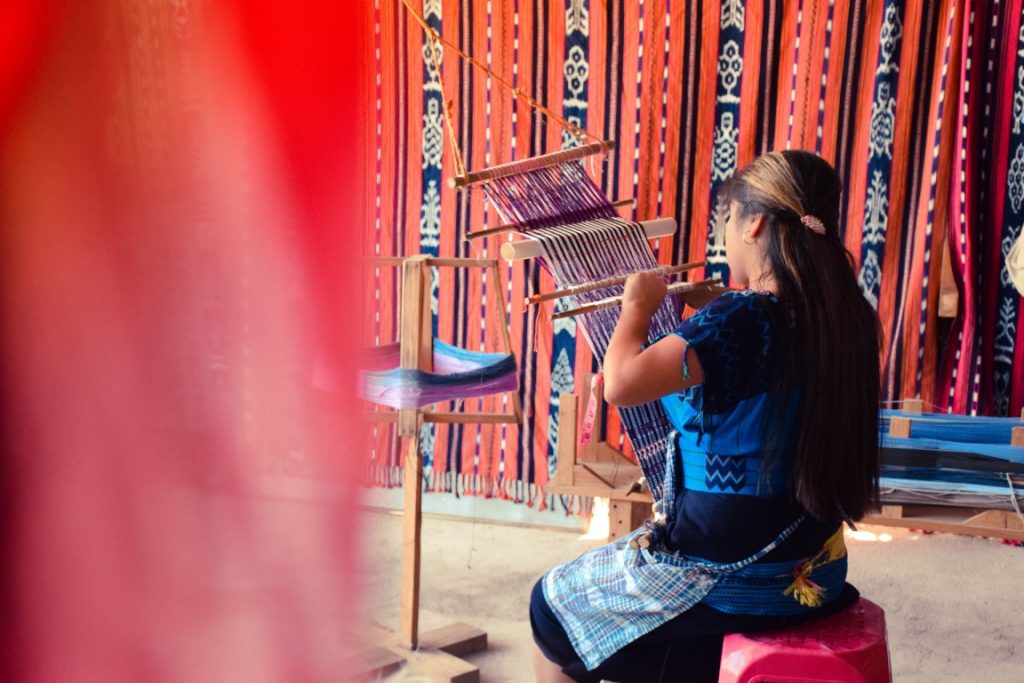Microfinance Can Change the World

We are claiming April as the month of Microfinance.
All are welcome to join our community: microfinance professionals, researchers, and enthusiasts; chief executive officers and loan officers; small, medium and large-scale microfinance institutions; microfinance institutions that operate in Bangladesh, Bolivia, Pakistan, South Africa, the United States…anywhere. Voices from the mainstream and voices of dissent are welcome. Diversity in our community will be accompanied by a diversity of experiences, beliefs, and narratives regarding microfinance.
Resources

What is Microfinance

Impact

Success Stories

News
About Month of Microfinance
We have a lot of questions. Some are expansive: When does the pursuit of scale come at the expense of clients? Does microfinance help move clients out of poverty? Others are specific: What is a fair interest rate to charge? Which fees are consistent with client-centered microfinance? Answers are good. But, conversation – nuanced conversation – that allows for ambiguities and explores the tensions at the heart of client-centered microfinance is even better.
Our Partners
To support our initiatives you can order custom stickers from our partner. The proceeds help with microfinance initiatives. Whether you need 50 custom stickers or 1000, you support matters. If you want to try before you order, you can get free sticker samples.
Read the Latest
Understanding Microfinance’s Contextual Limitations
Microfinance’s Historic Evolution
Microfinance, primarily aimed at offering financial assistance to the underserved, gained worldwide attention in the 1970s. Its essence was rooted in the belief that providing the poor access to credit would empower them to set up small businesses, leading to a sustainable escape from poverty. Muhammad Yunus, founder of Bangladesh’s Grameen Bank, played a significant role in promoting this concept, asserting that credit was a fundamental human right.
The 1997 Microcredit Summit in Washington, D.C., saw over 3,000 participants from over 140 countries endorsing microfinance’s potential. Yunus’s contribution to this movement was further recognized when he was awarded the Nobel Peace Prize in 2006. However, by 2019, the initial enthusiasm had waned. Although the number of borrowers had increased, it was insignificant compared to the global “unbanked” population, hinting that microfinance hadn’t lived up to its expectations.
Analyzing Microfinance’s Efficacy
While the primary goal of microfinance was to alleviate poverty, its actual impact remains questionable. Several studies, including one from MIT’s Poverty Action Lab in 2009, revealed no substantial evidence that microfinance services, particularly microloans, led to significant poverty reduction or sustainable economic development. These organizations, especially non-profit ones, were often blinded by immediate success stories, overlooking the broader contextual complexities that their clients faced.
Importance of Sociocultural Context
In regions with the highest poverty rates, most microloan recipients were involved in subsistence farming or petty trading. While microloans did provide them with the means to increase their inventory, this often led to increased risks rather than consistent profits. These individuals might have experienced short-term benefits, but their overall societal status remained unchanged. This brings us to a vital distinction between “condition” and “position.” Improving someone’s current state doesn’t necessarily change their societal standing, which is often determined by historical, sociocultural factors, and intricate political dynamics.
Challenging Assumptions
A foundational belief of microfinance was that borrowed money would be invested in businesses. However, in many cases, these loans were used to stabilize consumption patterns, helping individuals navigate financial hardships rather than fueling entrepreneurial ventures. Astonishingly, despite this, many microfinance initiatives still reported high repayment rates, masking the underlying issues borrowers faced.
Recognizing Existing Financial Systems
Contrary to popular belief, many developing societies already had intricate financial systems in place long before the introduction of microfinance. These systems, deeply rooted in their cultures and traditions, offered them ways to manage their financial needs, often more aligned with their realities than modern microfinance solutions. Interventions, no matter how well-intended, may not always be appropriate or necessary.
Distinguishing Entrepreneurs from Income Generators
A core assumption of microfinance was that the poor were inherently entrepreneurial. However, in reality, many were merely seeking ways to earn a stable income rather than harboring entrepreneurial ambitions. The barriers to entry in their markets were often low, which while making it easier for many to start, also led to saturated markets with little room for growth.
Key Takeaway: The Role of Context in Microfinance Success
Microfinance’s glaring oversight was its disregard for the multifaceted contexts in which it was implemented. For any development program to succeed, it’s imperative to grasp the sociocultural, economic, and historical nuances of the target community. It’s a reminder that while interventions can be powerful tools, they need to be wielded with a deep understanding of context.
Conclusion
Microfinance emerged with a vision to revolutionize poverty alleviation, and while it has indeed made strides, it’s evident that its broad-stroke approach may not be universally applicable. The next frontier in development needs a more nuanced approach, informed by the histories, cultures, and realities of the communities it seeks to serve.
Unlocking the Path to Financial Success: Setting Goals for Your Business
As a business owner, one of the keys to long-term success is setting and achieving financial goals. By establishing clear objectives, you can effectively manage your resources, plan for growth, and make informed decisions. In this guide, we will provide you with a comprehensive roadmap to set up business financial goals that align with your vision and drive success.
1. Assessing Your Current Financial Situation
Before embarking on setting business financial goals, it is crucial to assess your current financial situation. This involves conducting an in-depth analysis of your income, expenses, assets, and liabilities. By understanding your financial standing, you can identify areas that require improvement and set realistic goals accordingly.
2. Defining Your Vision and Objectives
The next step is to define your vision and objectives. Ask yourself: What do you want to achieve financially? Are you aiming for revenue growth, cost reduction, or increased profitability? Clearly articulate your objectives, ensuring they are specific, measurable, achievable, relevant, and time-bound (SMART goals).
3. Identify Key Performance Indicators (KPIs)
To effectively track your progress towards your financial goals, it is essential to identify key performance indicators (KPIs) that align with your objectives. KPIs can vary depending on your industry and business model but may include metrics such as revenue growth rate, gross profit margin, customer acquisition cost, or return on investment (ROI).
4. Break Down Your Goals into Actionable Steps
To avoid feeling overwhelmed by the magnitude of your financial goals, break them down into smaller, actionable steps. This approach allows for easier implementation and provides a sense of accomplishment as you achieve each milestone. Create a timeline with specific targets for each step and allocate resources accordingly.
5. Develop Strategies and Action Plans
To achieve your financial goals, you need to develop effective strategies and action plans. Consider the areas that need improvement or optimization based on your current financial situation. For example, if your goal is to increase revenue, you may focus on expanding your customer base, improving marketing campaigns, or enhancing product offerings.
6. Regularly Monitor and Track Progress
Once you have set your financial goals and developed action plans, it is crucial to monitor and track your progress regularly. Review your financial reports, analyze variances, and make adjustments as needed. Regularly reassess your strategies and action plans to ensure they are aligned with changing market conditions or business circumstances.
7. Seek Professional Advice
Setting and achieving business financial goals can be a complex process. Consider seeking professional advice from accountants, financial advisors, or business consultants who specialize in financial planning. They can provide valuable insights, help you navigate challenges, and ensure that your goals are realistic and attainable.
8. Celebrate Milestones and Adjust as Necessary
As you make progress toward your financial goals, it is essential to celebrate milestones and acknowledge your achievements. This boosts morale and motivates your team to stay focused on the journey ahead. However, remember that flexibility is key. Be prepared to adjust your goals and strategies if unforeseen circumstances arise or if market conditions change significantly.
9. Evaluate and Learn from the Process
Once you have achieved your financial goals, take the time to evaluate the process and learn from your experience. Identify what worked well and what could be improved in future goal-setting endeavors. This reflection allows for continuous improvement and sets the foundation for even greater financial success in the future.
Conclusion
Setting up business financial goals is a critical aspect of achieving long-term success. By assessing your current financial situation, defining your vision, and breaking down your goals into actionable steps, you can pave the way for financial prosperity. Regular monitoring, seeking professional advice when needed, and adapting to changing circumstances are all essential elements of this journey. With careful planning and determination, you can set your business on the path to financial success.
Exploring Alternative Funding Sources for Business Startups
When it comes to starting a business, securing the necessary funds is often one of the biggest challenges. While micro finances have gained popularity as a way to support startups, they might not be the ideal option for every entrepreneur. In this article, we will delve into five alternative funding sources that can provide you with the financial support you need to launch and grow your business.
Angel Investors
Angel investors are individuals who provide financial backing to startups in exchange for equity or convertible debt. These investors often have experience in the industry and are willing to take risks on promising business ideas. Unlike micro finances, which typically involve borrowing money, angel investors become partners in your venture. They not only provide capital but also offer guidance, mentorship, and valuable connections within the business community. Connecting with angel investors can be done through networking events, startup accelerators, or online platforms specifically designed for this purpose.
Crowdfunding
Crowdfunding has emerged as a popular way to raise funds for various projects, including business startups. This method involves reaching out to a large number of individuals or organizations who are willing to contribute small amounts of money toward your business idea. Platforms such as Kickstarter, Indiegogo, and GoFundMe have revolutionized the crowdfunding landscape, providing entrepreneurs with an opportunity to showcase their products or services to a wide audience. Crowdfunding allows you to validate your concept, build a community around your brand, and secure financial support from enthusiastic backers.
Venture Capitalists
Venture capitalists (VCs) are professional investors who provide funding to high-potential startups in exchange for equity. These individuals or firms manage funds contributed by other investors and seek opportunities to invest in businesses with significant growth potential. Unlike micro finances, which typically cater to smaller funding requirements, venture capitalists are more inclined to invest substantial amounts of capital in startups that demonstrate a strong value proposition and growth prospects. VCs not only bring financial resources but also offer strategic guidance and industry expertise.
Business Incubators and Accelerators
Business incubators and accelerators are organizations that provide support, resources, and funding to startups in their early stages. Incubators offer a nurturing environment where entrepreneurs can develop their ideas, access mentorship, and leverage shared facilities and services. On the other hand, Accelerators focus on fast-tracking startups’ growth through intensive mentoring, networking opportunities, and a time-bound program. Both incubators and accelerators often provide seed funding or access to networks of investors, which can be invaluable for startups seeking alternative funding options.
Small Business Grants
Government agencies, nonprofit organizations, and private foundations offer small business grants as a way to foster entrepreneurship and economic growth. Unlike loans, grants do not need to be repaid, making them an attractive option for startups looking to avoid debt. These grants are typically awarded based on specific criteria, such as industry focus, geographic location, or social impact. Researching and applying for small business grants can be time-consuming, but the potential benefits can be significant. Grants can provide the necessary capital to launch or expand your business while allowing you to retain full ownership and control.
In conclusion, while micro finances have their advantages, exploring alternative funding sources for your business startup can open up new possibilities. Angel investors, crowdfunding, venture capitalists, business incubators and accelerators, and small business grants are all viable options that can provide the financial support and resources necessary to turn your entrepreneurial vision into a reality. By diversifying your funding options and considering each alternative’s unique benefits, you can increase your chances of success and find the right fit for your business. Remember, the funding landscape is vast and dynamic, so stay proactive, seek opportunities, and be persistent in your pursuit of startup financing.
The Impact of Microfinance: Who is Eligible to Receive Microcredit?
Microfinance has been gaining popularity as an effective tool for financial inclusion and poverty alleviation. With over 1.7 billion people still unbanked worldwide, microfinance provides access to financial services to those who are excluded from the traditional banking system. But who exactly can benefit from microfinance, and how does it impact their lives? In this article, we delve into the world of microfinance and explore its beneficiaries.
What is Microfinance?
Microfinance refers to the provision of financial services, including credit, savings, insurance, and remittance, to the underserved and unbanked population. Microfinance institutions (MFIs) are specialized financial organizations that provide these services to low-income individuals, small business owners, and entrepreneurs who lack access to traditional banking facilities.
Microfinance has proven to be a successful strategy in promoting financial inclusion, social empowerment, and economic growth in developing countries. The concept originated in Bangladesh in the 1970s, when Nobel laureate Muhammad Yunus founded the Grameen Bank, which provided microcredit to impoverished women to start small businesses. Since then, microfinance has become a global phenomenon and has helped millions of people around the world.
Who Can Benefit from Microfinance?
Microfinance is primarily designed for people who lack access to traditional banking facilities, such as small business owners, farmers, artisans, and women entrepreneurs. Microcredit is a form of microfinance that provides small loans to people who do not have collateral or credit history. It is a crucial source of funding for micro-enterprises, which are often neglected by commercial banks.
In addition to small loans, microfinance institutions also provide other financial services, such as savings accounts, insurance, and remittance. These services are critical for individuals and families who live in poverty and do not have access to formal financial services.

How Does Microfinance Impact the Beneficiaries?
Microfinance has a profound impact on the lives of its beneficiaries. By providing access to financial services, microfinance institutions empower people to break the cycle of poverty and achieve financial stability. The benefits of microfinance are numerous and include:
1. Economic Growth and Job Creation
Microfinance promotes economic growth by providing funding for small businesses and entrepreneurs. Small businesses are the engine of economic growth, and microfinance helps them to thrive. By providing loans and other financial services, microfinance institutions help to create jobs, stimulate economic activity, and contribute to the overall development of the community.
2. Women’s Empowerment
Women are disproportionately affected by poverty, and microfinance has proven to be an effective tool for women’s empowerment. Women entrepreneurs who receive microcredit are more likely to invest in their businesses and improve their families’ living standards. Microfinance institutions often prioritize women’s empowerment by providing loans and other services exclusively to women.
3. Financial Inclusion
Microfinance is a critical tool for promoting financial inclusion. By providing financial services to the underserved and unbanked population, microfinance institutions help to bridge the gap between the rich and poor. This leads to greater social inclusion and economic equality.
4. Poverty Alleviation
Microfinance has a direct impact on poverty alleviation by providing access to financial services to the poor. Microcredit allows low-income individuals to start small businesses, generate income, and improve their living standards. This creates a ripple effect that helps to reduce poverty in the community.
5. Education and Health
Microfinance institutions also provide loans for education and healthcare, which are critical for people living in poverty. By financing education and healthcare, microfinance institutions help to improve the health and education outcomes of the community.
6. Resilience and Disaster Recovery
Microfinance plays a crucial role in building resilience in vulnerable communities. Microfinance institutions provide loans and other financial services to help people recover from natural disasters, such as floods, earthquakes, and hurricanes. This helps people to rebuild their homes and businesses and get back on their feet.
Conclusion
Microfinance is a powerful tool for financial inclusion and poverty alleviation. It provides access to financial services to those who are excluded from the traditional banking system and empowers them to break the cycle of poverty. Microfinance has a profound impact on the lives of its beneficiaries by promoting economic growth, women’s empowerment, financial inclusion, poverty alleviation, education and health, and resilience and disaster recovery. By investing in microfinance, we can help to create a more equitable and prosperous world for all.
Unveiling the Dark Side of Microfinance: Pitfalls and Precautions
Introduction
In recent years, microfinance has been widely touted as a powerful tool for poverty alleviation and financial inclusion. However, it is essential to recognize that microfinance is not a one-size-fits-all solution. This article delves into the lesser-known negative aspects of microfinance, analyzing potential pitfalls, and suggesting precautions to minimize harm to borrowers and communities.
Over-Indebtedness and Predatory Lending Practices
The Debt Trap
One of the most significant challenges associated with microfinance is the risk of over-indebtedness. As microfinance institutions (MFIs) strive to reach more clients and expand their portfolios, they may inadvertently encourage borrowers to take on more debt than they can handle. This can lead to a debt trap, where borrowers find themselves unable to repay their loans and must take out additional loans to cover their existing debts, further exacerbating their financial difficulties.
Predatory Lending
In some cases, MFIs may engage in predatory lending practices, such as charging exorbitant interest rates or imposing hidden fees. These unethical practices can exploit vulnerable borrowers who lack financial literacy and access to alternative credit sources. Consequently, borrowers may find themselves trapped in a cycle of debt, with little hope of escaping poverty.
Negative Social Impacts
Gender Discrimination and Disempowerment
While microfinance programs often target women as a means of promoting gender equality and empowering them economically, they can sometimes perpetuate gender discrimination and disempowerment. For example, in patriarchal societies, women may be pressured to hand over control of their microloans to male family members, undermining their financial autonomy. Additionally, some MFIs may inadvertently perpetuate harmful gender stereotypes by offering loans exclusively for stereotypically “female” enterprises, such as sewing or handicrafts.
Social Pressure and Cohesion
Many microfinance programs rely on group lending models, where borrowers are organized into small groups and held collectively responsible for loan repayments. While this model can create social support networks and encourage repayment, it can also lead to negative social consequences. Group members may experience intense pressure to repay loans, leading to stress, anxiety, and even ostracism for those who default. Moreover, these group dynamics can sometimes undermine community cohesion by creating tensions between members.
Environmental Concerns
Unsustainable Lending
Microfinance has the potential to contribute to environmental degradation if loans are provided for unsustainable businesses or practices. For example, if MFIs finance agricultural activities that rely heavily on harmful pesticides or deforestation, they may exacerbate environmental damage in the communities they serve.
Lack of Environmental Safeguards
Many MFIs lack comprehensive environmental safeguards, meaning they may not assess the environmental impact of the projects they finance. As a result, they may inadvertently support environmentally harmful activities, undermining their mission to promote sustainable development.

Recommendations and Precautions
Responsible Lending Practices
To minimize the risk of over-indebtedness and predatory lending, MFIs should adopt responsible lending practices, including transparent pricing, adequate borrower assessment, and providing financial education. By ensuring that borrowers fully understand the terms and conditions of their loans and are capable of repaying them, MFIs can reduce the likelihood of creating debt traps.
Promoting Gender Equality and Inclusion
To counteract potential gender discrimination and disempowerment, MFIs should adopt gender-sensitive policies and practices. This could include offering tailored financial products and services that cater to the diverse needs of women and men, and providing training and support to promote women’s economic empowerment. Furthermore, MFIs should be cautious of reinforcing harmful gender stereotypes through their lending practices.
Strengthening Social Cohesion
To mitigate the negative social impacts of group lending models, MFIs should provide training and support to help borrowers navigate group dynamics and foster positive relationships. Additionally, MFIs could consider alternative lending models, such as individual loans or hybrid models that combine elements of group and individual lending, to reduce the potential for social tensions.
Integrating Environmental Sustainability
To address environmental concerns, MFIs should incorporate environmental sustainability into their lending policies and practices. This could involve conducting environmental impact assessments for financed projects and promoting environmentally-friendly businesses and practices. Moreover, MFIs should consider offering green loans and other financial products specifically designed to support sustainable development.
Conclusion
While microfinance has undoubtedly helped millions of individuals and small businesses access much-needed financial services, it is crucial to recognize and address its potential dark side. By adopting responsible lending practices, promoting gender equality and social cohesion, and integrating environmental sustainability into their operations, MFIs can help ensure that microfinance remains a powerful tool for poverty alleviation and inclusive development.
The Month of Microfinance Goals: Advancing Financial Inclusion for All
Microfinance has emerged as a powerful tool in the fight against poverty by providing access to financial services for those who are traditionally excluded from the formal banking sector. Microfinance institutions (MFIs) have been instrumental in providing loans, savings accounts, and other financial services to millions of people worldwide. In recognition of this vital work, October is celebrated as the Month of Microfinance Goals, highlighting the achievements and potential of microfinance as a means of advancing financial inclusion for all.
1. Understanding Microfinance
Microfinance refers to the provision of financial services, including loans, savings accounts, insurance, and other financial products, to low-income individuals and groups who lack access to traditional banking services. Microfinance institutions (MFIs) are dedicated to providing financial support to those who need it the most, particularly in developing countries.
2. The Importance of Financial Inclusion
Access to financial services is critical for individuals and communities to improve their economic and social well-being. Without access to financial services, people may be forced to rely on informal and often costly financial services, limiting their ability to save, invest, and plan for the future. Financial inclusion is a vital element in the fight against poverty, providing individuals with the tools and resources they need to break the cycle of poverty and achieve long-term financial stability.
3. The Role of Microfinance Institutions
MFIs play a crucial role in providing access to financial services for the unbanked and underbanked populations. By providing small loans and other financial products, MFIs empower individuals to start or grow small businesses, build assets, and improve their quality of life.
4. Microfinance Goals and the SDGs
The Sustainable Development Goals (SDGs) are a universal call to action to end poverty, protect the planet, and ensure that all people enjoy peace and prosperity by 2030. Microfinance goals are closely aligned with the SDGs, particularly SDG 1: No Poverty and SDG 8: Decent Work and Economic Growth.
5. The Month of Microfinance Goals
The Month of Microfinance Goals is an opportunity to celebrate the achievements of MFIs and raise awareness about the importance of financial inclusion. During this month, MFIs and their partners organize events and campaigns to highlight the role of microfinance in advancing financial inclusion and reducing poverty.
6. The Potential of Microfinance
Microfinance has the potential to transform the lives of millions of people worldwide by providing access to financial services that were previously unavailable. By providing small loans, savings accounts, and other financial products, microfinance institutions can help individuals and communities build assets, start businesses, and achieve financial stability.
7. Microfinance and Women’s Empowerment
Microfinance has been particularly effective in empowering women, who are often excluded from the formal banking sector. By providing access to financial services, women can start or grow small businesses, invest in education and healthcare, and contribute to the economic and social development of their communities.
8. Challenges in Microfinance
Despite its potential, microfinance faces significant challenges, including inadequate funding, high costs, and limited regulatory frameworks. In addition, the COVID-19 pandemic has had a significant impact on the microfinance sector, with many MFIs struggling to maintain operations and provide support to their clients.
9. The Future of Microfinance
As the world continues to grapple with the COVID-19 pandemic, the role of microfinance in advancing financial inclusion and reducing poverty has become more critical than ever. Microfinance institutions will need to adapt to new challenges and opportunities, leveraging technology and partnerships to reach more people and provide better services.
10. Supporting Microfinance
There are many ways individuals and organizations can support microfinance and advance financial inclusion. One way is to support MFIs directly by making donations, investing in microfinance funds, or volunteering. Another way is to support policy changes that promote financial inclusion and enable the growth of the microfinance sector.
11. Microfinance Success Stories
Microfinance has helped millions of people around the world improve their lives and escape poverty. There are countless success stories of individuals and communities who have used microfinance to start or grow businesses, build assets, and achieve financial stability. These success stories serve as powerful examples of the potential of microfinance to change lives.
12. Microfinance and Innovation
Innovation has played a critical role in the growth and success of microfinance. The use of technology, such as mobile banking and digital payments, has enabled MFIs to reach more people and provide better services. In addition, new financial products, such as microinsurance and microleasing, are expanding the range of services available to microfinance clients.
13. Microfinance and Environmental Sustainability
Microfinance is not just about financial inclusion; it can also play a role in promoting environmental sustainability. Microfinance institutions are increasingly incorporating environmental considerations into their lending practices, supporting sustainable agriculture, renewable energy, and other green initiatives.
14. Conclusion: The Power of Microfinance
The Month of Microfinance Goals is a reminder of the power of microfinance to advance financial inclusion and reduce poverty. Despite the challenges it faces, microfinance can potentially transform the lives of millions of people worldwide. By supporting microfinance, we can help build a more just and equitable world, where everyone can access the financial tools and resources needed to thrive. Microfinance can help people start their own businesses.
